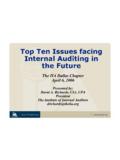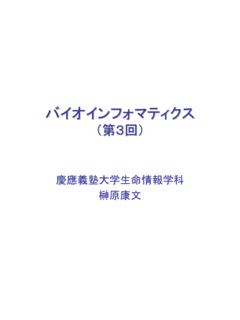Transcription of Auditing Application Controls - interniaudit.cz
1 AuditingApplication ControlsIPPF Practice GuideGlobal Technology Audit Guide (GTAG) 8: Auditing Application ControlsAuthorsChristine Bellino, Jefferson WellsSteve Hunt, Crowe Horwath LLP Original print date: July 2007. Revised for consistency with the International Professional Practices Framework (IPPF) January 2009. Copyright 2007 by The Institute of Internal Auditors (IIA), 247 Maitland Ave., Altamonte Springs, FL 32701-4201 USA. All rights reserved. Printed in the United States of America. No part of this publication may be reproduced, stored in a retrieval system, or transmitted in any form by any means electronic, mechanical, photocopying, recording, or otherwise without prior written permission from the IIA publishes this document for informational and educational purposes. This document is intended to provide information, but is not a substitute for legal or accounting advice. The IIA does not provide such advice and makes no warranty as to any legal or accounting results through its publication of this document.
2 When legal or accounting issues arise, professional assistance should be sought and Executive Summary ..12. Introduction ..2 Defining Application Controls ..2 Application Controls Versus IT General Controls ..2 Complex Versus Non-complex IT Environments ..3 Benefits of Relying on Application Controls ..3 The Role of Internal Auditors ..43. Risk Assessment ..7 Assess Risk ..7 Application Control: Risk Assessment Approach ..84. Scoping of Application Control Reviews ..9 Business Process Method ..9 Single Application Method ..9 Access Controls ..95. Application Review Approaches and Other Considerations ..10 Planning ..10 Need for Specialized Audit Resources ..10 Business Process Method ..10 Documentation Testing ..13 Computer-assisted Audit Techniques ..136. Appendices ..18 Appendix A: Common Application Controls and Suggested Tests ..18 Appendix B: Sample Audit Program ..217. Glossary.
3 268. References ..279. About the Table of Contents1 Over the last several years, organizations around the world have spent billions of dollars upgrading or installing new business Application systems for different reasons, ranging from tactical goals, such as year 2000 compliance, to strategic activities, such as using technology as an enabler of company differentiation in the marketplace. An Application or Application system is a type of software that enables users to perform tasks by employing a computer s capabilities directly. According to The Institute of Internal Auditors (IIA s) GTAG 4: Management of IT Auditing , these types of systems can be classified as either transactional applications or support applications process organizationwide data by: Recording the value of business transactions in terms of debits and credits. Serving as repositories for financial, operational, and regulatory data.
4 Enabling various forms of financial and managerial reporting, including the processing of sales orders, customer invoices, vendor invoices, and journal entries. Examples of transactional processing systems include SAP R/3, PeopleSoft, and Oracle Financials, which are often referred to as enterprise resource planning (ERP) systems, as well as countless other non-ERP examples. These systems process transactions based on programmed logic and, in many cases, in addition to configurable tables that store unique organizational business and processing the other hand, support applications are specialized software programs that facilitate business activities. Examples include e-mail programs, fax software, document imaging software, and design software. However, these applications generally do not process with any technology that is used to support business processes, transactional and support applications may pose risks to the organization, which stem from the inherent nature of the technology and how the system is configured, managed, and used by employees.
5 With respect to transactional processing systems, risks can have a negative impact on the integrity, completeness, timeliness, and availability of financial or operational data if they are not mitigated appropriately. Furthermore, the business processes themselves will have some element of inherent risk, regardless of the Application used to support them. As a result of these Application technology and business process risks, many organizations use a mix of automated and manual Controls to manage these risks in transactional and support applications. However, the degree of successful risk management is directly dependent upon: The organization s risk appetite, or tolerance. The thoroughness of the risk assessment related to the Application . The affected business processes. The effectiveness of general information technology (IT) Controls . The design and ongoing extent of operating effectiveness of the control activities.
6 One of the most cost-effective and efficient approaches organizations use to manage these risks is through the use of Controls that are inherent or embedded ( , three-way match on account payable invoices) into transactional and support applications as well as Controls that are configurable ( , accounts payable invoice tolerances). These types of Controls are generally referred to as Application Controls those Controls that pertain to the scope of individual business processes or Application systems, including data edits, separation of business functions, balancing of processing totals, transaction logging, and error It is also important for chief audit executives (CAEs) and their staff to understand the difference between Application Controls and IT general Controls (ITGCs). The ITGCs apply to all organizationwide system components, processes, and data,3 while Application Controls are specific to a program or system supporting a particular business process.
7 The Application Controls Versus IT General Controls section of this chapter will go into greater detail about these two types of to the importance of Application Controls to risk management strategies, CAEs and their teams need to develop and execute audits of Application Controls on a periodic basis to determine if they are designed appropriately and operating effectively. Therefore, the objective of this GTAG is to provide CAEs with information on:1. What Application Controls are and their The role of internal auditors. 3. How to perform a risk assessment. 4. Application control review Application review approaches and other further assist CAEs or other individuals who use this guide, we also have included a list of common Application Controls and a sample audit plan. GTAG Executive Summary 11 GTAG 4: Management of IT Auditing , p.
8 GTAG 1: Information Technology Controls , p. GTAG 1: Information Technology Controls , p. Application ControlsApplication Controls are those Controls that pertain to the scope of individual business processes or Application systems, including data edits, separation of business functions, balancing of processing totals, transaction logging, and error reporting. Therefore, the objective of Application Controls is to ensure that: Input data is accurate, complete, authorized, and correct. Data is processed as intended in an acceptable time period. Data stored is accurate and complete. Outputs are accurate and complete. A record is maintained to track the process of data from input to storage and to the eventual types of Application Controls exist. These include: Input Controls These Controls are used mainly to check the integrity of data entered into a business Application , whether the data is entered directly by staff, remotely by a business partner, or through a Web-enabled Application or interface.
9 Data input is checked to ensure that is remains within specified parameters. Processing Controls These Controls provide an automated means to ensure processing is complete, accurate, and authorized. Output Controls These Controls address what is done with the data and should compare output results with the intended result by checking the output against the input. Integrity Controls These Controls monitor data being processed and in storage to ensure it remains consistent and correct. Management Trail Processing history Controls , often referred to as an audit trail, enables management to identify the transactions and events they record by tracking transactions from their source to their output and by tracing backward. These Controls also monitor the effectiveness of other Controls and identify errors as close as possible to their Application control components include wheth-er they are preventive or detective.
10 Although both control types operate within an Application based on programmed or configurable system logic, preventive Controls perform as the name implies that is, they prevent an error from occur-ring within an Application . An example of a preventive con-trol is an input data validation routine. The routine checks to make sure that the data entered is consistent with the associated program logic and only allows correct data to be saved. Otherwise, incorrect or invalid data is rejected at the time of data entry. Detective Controls also perform as the name implies that is, they detect errors based on a predefined program logic. An example of a detective control is one that discovers a favorable or unfavorable variation between a vendor invoice price and the purchase order price. Application Controls , particularly those that are detective in nature, are also used to support manual Controls used in the en-vironment.






